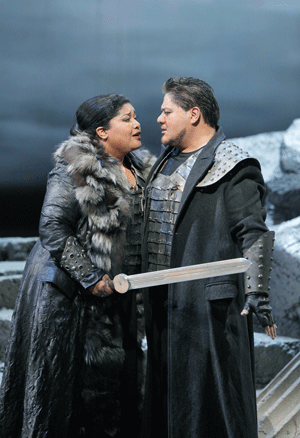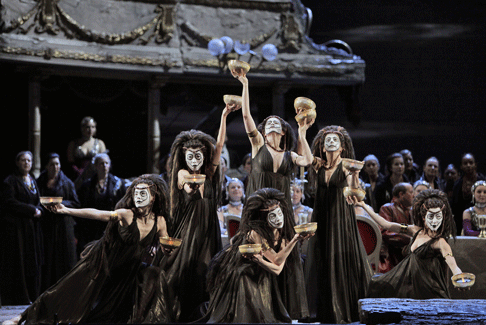He did have some debts just then and patriotic operas were good box office in Venice so why not an opera about the barbaric general who scared the population off of dry land out into the lagoon that finally became La Serenissima.
 Lucrecia Garcia as Odabella and Diego Torre as Foresto
Lucrecia Garcia as Odabella and Diego Torre as Foresto
Attila is not big at the box office these days as there are too many better operas that attract and please the public and that better illuminate the Verdi genius as well. But it is Verdi, the early Verdi, and it is fiery music with hints of the late, great Verdi who ultimately created the Venetian general Otello. It is the Verdi who pushed singers to and beyond technical limits but not yet the Verdi who had transformed virtuoso voices into the complex dramatic personas that transcend mere technique.
So Attila is about voices, let’s start there. The real Attila the Hun was probably fairly young when he descended from Hungary as far as Rome (there is no recorded birthdate). It was the young American bass Samuel Ramey who took on Attila back in 1981 and made him his own of which there is much discography. The elder Mr. Ramey was just now on the stage of the War Memorial no longer as the Hun but as the bishop Leo who implores Attila to turn back. Mr. Ramey’s voice proves his long career, a still strong tone of now monumental wobble. But Mr. Ramey’s presence was obviously not to sing or be Leo but to be Mr. Ramey.
This formidable Italian bass Ferruccio Furlanetto is however in his prime, traversing Attila’s emotional poles and vocal treacheries with ease, reaching the high notes of its extreme range with force and security, descending to the suave tones that evoke the sexual allure of a powerful man. In better circumstances the tall, fit and heroic Mr. Furlanetto would have motivated dramatic tensions that lie just beneath the surface, and exploited the hints of Otello and Desdemona that lurk there.
International opera becomes ever more international, witness the fortunate discovery of young Venezuelan soprano Lucrezia Garcia. Mlle. Garcia was Odobella whose father had been slain by Attila and who married Attila. Mozart had already played with this situation in more obvious circumstances. However these hidden complexities were ignored in this San Francisco production leaving Mlle. Garcia as nothing more than a singer. The role is vocally formidable as was this singer who adds extraordinary agility to a powerful voice of real sweetness.
Mexican tenors have long since been discovered, so the discovery of tenor Diego Torre from Domingo’s L.A. Opera young artist program comes as no surprise. Mr. Torre brought security and strength to his vocal delivery of Odobella’s suitor Foresto, and his youthfulness added a bit of wanted charm to the opera’s most strident music (not in short supply). Verdi was never too kind to his tenors, usually finding them of questionable integrity, like Foresto, but Mr Torre was offered no opportunity to be more than a good singer.
Add to these two fine young singers Hawaiian baritone, Quinn Kelsey, a wonderful young singer who essayed Ezio, a Roman general who is the foil of Attila, i.e. he is the patriotic spirit of Italy. These days casting at San Francisco Opera seems to surround one big star with up and coming (at best) stars and with house singers, like Mr. Kelsey. This kind of casting often results in miss matching musical and/or histrionic styles, miss matching body types and over parting (a singer not yet or maybe ever able to take on a certain role). Pitted against Mr. Furlanetto My. Kelsey had no chance to deliver this proto-Verdi-baritone role with requisite force of voice or personality. His once famous second act aria of heroic resolution … gettata la mia sorte fell quite short of generating the excitement needed to unify Italy.
 Act II of Attila
Act II of Attila
Not much can be known about the death of Attila in 453, though most certainly it was not at the hands of Odabella who in the opera saves his life so that she can kill him. Since this murder is pure fantasy anyway Italian film star and opera director Gabriele Lavia set the murder scene in a movie theater, complete with a screen on which Jack Palance was sacking Rome (the size and movement of the film images compelled our attention more forcefully than the miniscule by comparison singers — “what idiocy” was an overheard comment). But never mind as the second act was set in an opera house for some reason — maybe because Attila is an opera? The first act was the Roman amphitheater in Aquila and it looked just like the Arena di Verona where singers more or less line up across the front of the stage and sing.
Which is where maestro Nicola Luisotti likes his singers and Mr. Lavia seems happy to oblige. The maestro needs total control to impose his egomaniacal musicianship. It is effervescent, and seductive for a while, and this Verdi score obliges this maestro with the opportunity to be legitimately bombastic. The few moments of descriptive music offered by Verdi were overwhelmed by Luisotti’s penchant for effect. Effect for its own sake is a pitfall of this early Verdi opera that in its first years elicited the critical comments that began this review.
Michael Milenski
image=http://www.operatoday.com/Attila-03.gif
image_description=Ferruccio Furlanetto as Attila [Photo by Cory Weaver courtesy of San Francisco Opera]
product=yes
product_title=Giuseppe Verdi: Attila
product_by=Attila: Ferruccio Furlanetto; Odabella: Lucrecia Garcia; Foresto: Diego Torre; Ezio: Quinn Kelsey; Uldino: Nathaniel Peake; Pope Leo I: Samuel Ramey. Chorus and Orchestra of San Francisco Opera. Conductor: Nicola Luisotti; Stage Director: Gabriele Lavia; Set Designer: Alessandro Camera; Costume Designer: Andrea Viotti; Lighting Designer: Christopher Maravich. War Memorial Opera House, San Francisco, June 12, 2012.
product_id=Above: Ferruccio Furlanetto as Attila
Photos by Cory Weaver courtesy of San Francisco Opera